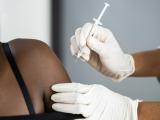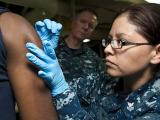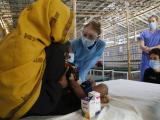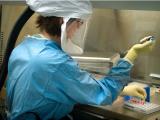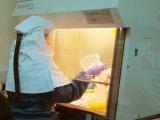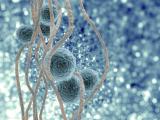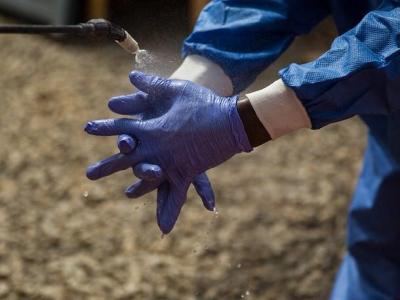Oct 10, 2011
Trio says tin, silicon point to specialized manufacture in '01 anthrax attacks
Three scientists claim in a new paper that distinctive chemicals found in dried Bacillus anthracis spores mailed 10 years ago to two senators' offices and three media outlets cast doubt on whether one person working alone perpetrated the anthrax attacks, according to a New York Times story yesterday. Other experts, however, question the claim, saying the chemicals—including tin—may simply be random contaminants. The attacks killed 5 and sickened 17. The paper is slated to be published in mid-November in the Journal of Bioterrorism & Biodefense, lead author Martin Hugh-Jones of Louisiana State University said in a ProMED-mail post today. According to the Times, the FBI called tin an "element of interest" early in the criminal probe that eventually fingered Bruce E. Ivins of the Army biodefense lab at Ft. Detrick, Md., as acting alone and producing the B anthracis spores with equipment in his possession. However, the three authors—Hugh-Jones, retired biochemist Barbara Hatch Rosenberg, and chemist Stuart Jacobsen—assert that a silicon-tin coating on the spores points to a high level of manufacturing skill and lends support to a theory that Ivins could not have made the B anthracis powder alone with his lab's equipment. All three authors are longtime critics of the FBI investigation. The story also says that Alice P. Gast, who chaired a National Research Council (NRC) panel that reviewed the case, said the new claims "deserve further consideration," a sentiment echoed by Nancy Kingsbury, who is overseeing a Government Accountability Office review of the evidence. But Jonathan Kiel, a retired Air Force anthrax expert, said the silicon and tin may have been picked up in the lab. In addition, the NRC's report emphasized that the scientific evidence was only one part of the FBI's investigation.
Oct 9 Times story
Oct 10 ProMED-mail post
Feb 15 and Feb 16 CIDRAP News stories on NRC report
Study: Jet injector flu vaccination comparable to needle delivery
The first human trial of seasonal flu vaccine administered by a newly approved needle-free jet injector found that immunization was safe, with an immune response similar to the needle and syringe method, according to a new study in Vaccine. The LectraJet injector used in the study was approved by the US Food and Drug Administration (FDA) in December 2009. The new system was developed by D'Antonio Consultants International, with support from the US Centers for Disease Control and Prevention (CDC), according to the company's Web site. The system is designed to minimize risk of needlestick injuries in a mass vaccination setting, and a motorized high-speed model that could speed immunizations is under investigation. Of, 60 healthy adults who received one 0.5-milliliter intramuscular dose of the 2009-10 seasonal flu vaccine, half got jet injection and half got the needle version. Investigators monitored adverse reactions for 90 days after injection and measures serologic response by hemagglutination inhibition (HI) at days 28 and 90. No serious adverse events occurred. Transient erythema and induration were reported more often after jet injection, though that system was associated with fewer systemic reactions. No differences in seroconversion or seroprotection were noted, and the authors pointed out that the sample size was too small to conduct a noninferiority assessment. The authors concluded that, despite the small sample size, jet injection flu vaccine delivery is close to satisfying FDA guidelines.
Oct 8 Vaccine abstract
D'Antonio Consultants International, Inc., LectraJet background materials
HIV patients show poor response to unadjuvanted H1N1 vaccine
A study of unadjuvanted 2009 H1N1 vaccine in adults infected with HIV showed a poor immunogenic response, with only a limited benefit of a second booster dose, according to a research group from Japan writing in Vaccine. They enrolled 104 patients with HIV who were scheduled to receive the 2009 H1N1 vaccine in late 2009 and early 2010, which was an inactivated split-virus version administered subcutaneously. Investigators measured subjects' anti-H1N1 antibody titers at enrollment and 4 to 8 weeks after each vaccination by HI and virus neutralization. Patient chose whether to receive one or two 15-microgram doses of the vaccine. After the first dose, seroconversion was observed in 50% of patients, based on HI assay, and 47.1% based on virus neutralization assay. In those who received a second dose, the seroconversion rate based on HI antibodies was 44.4% after the first dose and 48.1 % after the second dose. The researchers said it's unclear why patients with HIV respond poorly to the unadjuvanted 2009 H1N1 vaccine. Lower CD4 cell counts haven't been definitively linked to the poor response, and the current study found only a weak correlation between HIV RNA suppression and virus neutralization antibody response. The researchers noted that other studies have found a modest benefit of a booster dose of adjuvanted 2009 H1N1 vaccine for HIV patients.
Oct 4 Vaccine abstract
13-strain pneumococcal vaccine safe, immunogenic after 7-strain version in kids
Administering 13-valent (13-strain) pneumococcal conjugate vaccine (PCV13) in preschoolers after they had received the seven-valent version (PCV7) was shown to be safe and immunogenic in a recent trial. Researchers administered PCV13 to 109 children aged 15 months to 2 years and to 175 children between 2 and 5 years old, all of whom had previously received PCV7. The younger group received two vaccine doses. The research team measured immunoglobulin G (IgG) antibodies before vaccination and 1 month after the final dose. They noted anti-pneumococcal IgG geometric mean rises ranging from about 2- to 19-fold for the PCV7 serotypes and from about 2- to 124-fold for the six added serotypes. They found that 98% or more of subjects in each group reached a postvaccine serologic correlate of immunity for this age-group (titer of 0.35 microliters per milliliter) for 12 of the 13 serotypes. For serotype 3, which is not found in PCV7, 94.5% of the younger group and 92% of the older group reached this threshold. The researchers also found low rates of adverse events.
Oct 6 Ped Infect Dis J abstract
